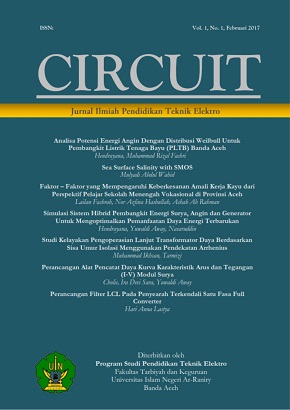Analisis Kelayakan Air Berbasis Android
DOI:
https://doi.org/10.22373/crc.v5i2.9718Keywords:
Water quality, Turbidity sensor, TDS sensor, Arduino, bylink appAbstract
This research was conducted to identify the test of the water quality which good for consumption. It can be proved from temperature, turbidity level, and TDS (Total Dissolved Solids). By tempting the sensor, the turbidity and TDS meter controlled with the Arduino uno and the MCU node is forwarded to send data to the bylink application. The bylink application will help in monitoring water conditions by displaying the water condition which fit for consuming. The method used in this research was started with making a prototype then producing data to determine the feasibility of water through the TDS sensor, temperature sensor, and NTU (water clarity). This indicators were developed on an Android system whom the user could determine feasibility water easier.
References
Kadir, A.. (2016). Simulasi Arduino. Jakarta: Elex Media Komputindo.
Peraturan Menteri Kesehatan Republik Indonesia. (2010). Tentang
Persyaratan Kualitas Air Minum. No. 492/MENKES/PER/IV/2010.
Resistor, Karakteristik, Nilai, dan Fungsinya. (2017).
(http://zonaelektro.net/resistor- karakteristik-nilai-dan- fungsinya/,
diakses 25 Mei 2021)
Universitas Medan Area. (2020). Apa Itu Arduino Uno.
(https://elektro.uma.ac.id/2020/1 1/30/apa-itu-arduino-uno/, diakses 25
Mei 2021)
Wadu, R.A., Ada, Y.S.B., & Panggalo, I.U. (2017). Rancang Bangun Sistem
Sirkulasi Air Pada Akuarium /Bak Ikan Air Tawar Berdasarkan
Kekeruhan Air Secara Otomatis. Jurnal Ilmiah Flash, 31, pp.1-10.
WHO. (2003). Total dissolved solid in Drinking-water. World Health
Organization, Geneva, Switzerland.
Downloads
Published
Issue
Section
License
Authors who publish in CIRCUIT: Jurnal Ilmiah Pendidikan Teknik Elektro agree to the following terms:
- Authors retain copyright and grant the journal right of first publication with the work licensed under a Creative Commons Attribution-ShareAlike 4.0 International License (CC BY-SA 4.0) that allows others to share and adapt the work with an acknowledgement of the authorship and initial publication in this journal
- Authors are able to enter into separate, additional contractual arrangements for the non-exclusive distribution of the journal's published version of the work (e.g., post it to an institutional repository or publish it in a book), with an acknowledgment of its initial publication in this journal.
- Authors are permitted and encouraged to post their work online (e.g., in institutional repositories or on their website) prior to and during the submission process, as it can lead to productive exchanges, as well as earlier and greater citation of published work. (See The Effect of Open Acces)

